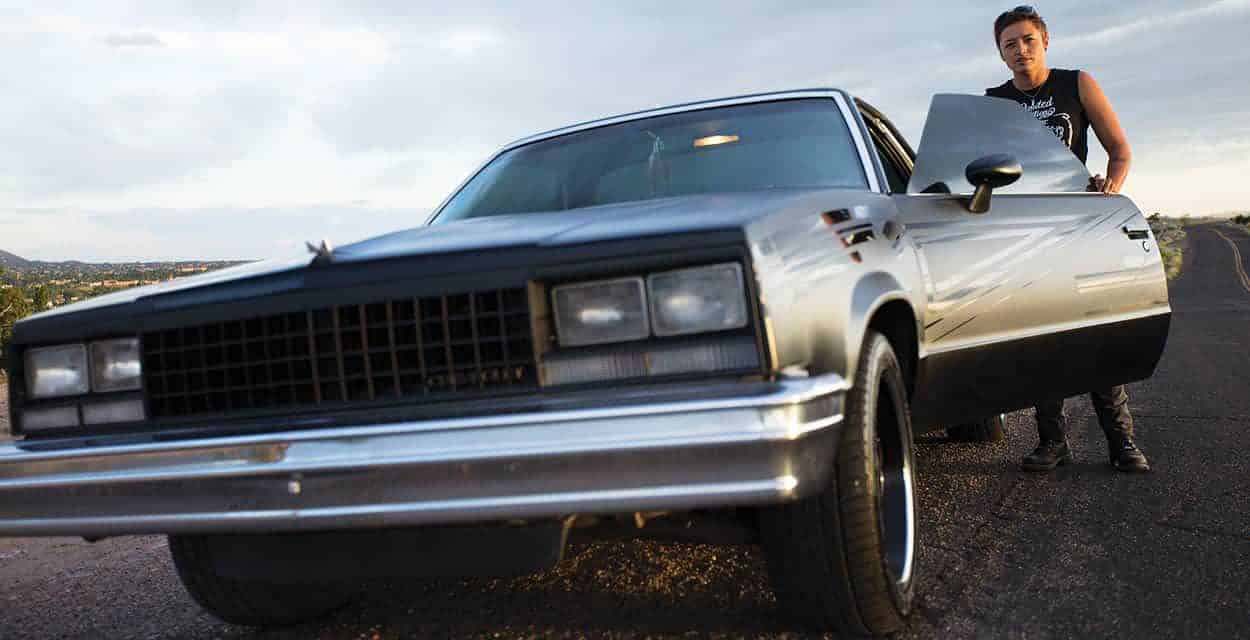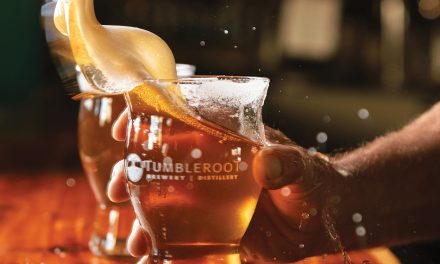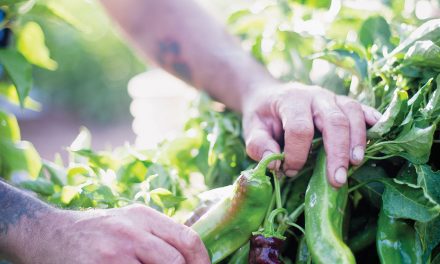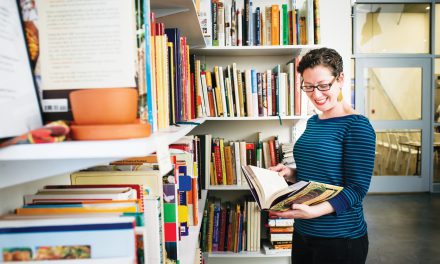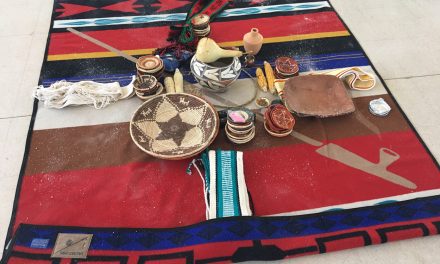Down to Earth in the Española Valley
By Briana Olson

Artisit Rose Simpson and her El Camino. Photo by Kate Russell.
“What is art?” Rose Simpson asks. “How do you make your refrigerator something beautiful?” We’re standing in the artist’s studio on Santa Clara land at Española’s city limit, and the androgynous clay figure on her work table presents itself as one answer—to the first question, at least. But Simpson isn’t talking about that sculpture, or her installation at the Wheelwright Museum of the American Indian, dominated by post-apocalyptic indigenous warrior figures that any curator or collector would classify as art. She’s talking about the distinction between art and craft, between that which is conceived purely as art and that which has a function, a use. A clay bowl, for instance, or a car.
A car, in fact, is what drew me to begin my tour of Española in Simpson’s studio. Maria is a 1985 El Camino, a long sleek black machine painted to resemble the black-on-black pottery style perfected by the legendary Maria Martinez of Ildefonso Pueblo. As we cross to the garage where Maria is parked, Simpson points across the yard to a couple of other cars that look, to the untrained eye, like junk. One is the 1968 Buick Skylark that she started at the automotive program at Northern New Mexico College with the intention of rebuilding.
Then she bought the El Camino.
El camino translates literally as the path or the road, but it’s hard to look at Maria without thinking of El Camino Real. The historic route runs through Española, the lowrider capital of the world, said to have been named for all the Spanish girls met by railroad workers here in the 1880s. It starts—or ends—in Ohkay Owingeh, where a certain group of Spaniards arrived one irrevocable day in 1598.
In the lowrider scene, every car has its story. Simpson tells me how she brought the El Camino out to the field to put it to use during harvest. Looking at the car filled with corn and beans and squash, she suddenly saw it as a vessel. She decided to build Maria before finishing the Buick. It’s not exactly a lowrider—Simpson installed a four hundred ten horsepower Chevy 350 engine that makes cruising “low and slow” borderline impossible—and it’s not exactly a bowl, but the car is an homage to the Chicano roots of lowrider culture and the Tewa traditions of pottery.
“Maria is intended to be a cultural conversation about how we’ve had to coexist,” she says, “and how can we honor that. And we do share a lot of aesthetics.”
She talks about the healing power of everyday aesthetics, how we derive meaning from the cars we drive, the way we prepare the food we eat, and the plates on which it is served.
“What feeds you?” she asks.
“Family and friends,” Chris Quintana answers when I ask his favorite thing in the Española Valley. Quintana is a manager of Angelina’s Restaurant on Railroad Avenue (and grandson of founding owners Fidel and Angelina Gutierrez), whose large, open dining room is busy with families and friends when I step in. A small flock of ceramic chickens lines the low wall that supports a row of turquoise and beige booths. Square, wood-framed windows are spaced evenly along the outside walls, letting in lots of light despite the thunderclouds building outside.
I read Angelina’s entire menu even though I already know what I want: chicos. Chicos are made from sweet corn picked young and steamed, in-husk, in an horno, then sun-dried. It’s a labor-intensive dish rooted in ancestral Puebloan tradition, and appears but rarely on urban menus. These chicos, the waitress tells me, are sourced from nearby Velarde. They are sweet, smaller and lighter than the hominy used to make posole, and the kernels burst with the juicy crunch of fresh corn. Cubed pork floats in the broth, touched with red from the chile—a soothing dish for a stormy spring day. The sopaipillas achieve a rare perfection: fluffy, light, crisp, and fresh. I order a side of red chile because I want to taste it head on, and because it’s my favorite condiment for sopas. The sauce is a rich red, tangy but smoky, with just a shade of bitter.
Next I cross the bridge to Santa Cruz, where the Iglesia de Santa Cruz de Cañada—also known as Holy Cross Catholic Church—was built between 1733 and 1748. I’m disappointed to find the heavy wooden doors locked, but as I circle the courtyard, a groundskeeper calls out to me.
“When is it open?” I ask.
“Did you want to go to a mass?”
The question almost surprises me. It’s a reminder that the church’s preservation is not only to honor colonial art and architecture; it remains a contemporary place of worship, of gathering.
I admit that I don’t want to attend mass, and the groundskeeper lets me in through the back. Inside, I am steeped in a sense of calm, the thick and beautifully maintained adobe walls and vigas creating an atmosphere of refuge even as I am conscious that the Tanos peoples were forced out of Santa Cruz during the reconquest, prior to the church’s construction. I try on Simpson’s idea of holding space, remembering that loss even as I admire the artistry of early santeros like José Rafael Aragón. At the top of one altar panel, a bird overlooks a cross flanked by flowers and what I take to be cacti. It’s an experience altogether different from viewing Aragón’s works on the walls of a museum.

Joan Medina with her 1960 Impala lowrider. Photo by Kate Russell.
Maybe it’s that thought that inspires me to wander. Maybe it’s a longing to find something that’s not on my itinerary—what, for me, is the crux of travel. Discovery. An open mind. Can I really say I’ve been somewhere if I’ve never gotten a little lost there?
What stops me, west of the river, at an intersection that seems familiar but not, are the murals. The first one I see is a visual ode to Española, painted two years ago (I learn later) by local artist Cruz Lopez. A cavalcade of lowriders and conquistadors on horseback converge in the foreground, with Holy Cross and the Sikh temple side by side in the rear. Across the street, the Hunter Community Mural Project blends naturalistic painting with Pueblo patterns, relishing the valley’s agricultural history. Farther along, I find Nani Chacon’s gorgeous The River Flows Through It. I love the vitality of street art, even when viewed through the windshield, but this work is more than worth the time it takes to get out of the car.
A few minutes later, I pass El Parasol, and can’t resist pulling in for some tacos. Sitting at a picnic table in front of the iconic stand, I’m joined by an LA hipster with the word “Trailblazer” patched on his jean jacket. His travel companion tells me she has yet to find tacos this good anywhere else. If the taco is an art, these fall right in the “New Mexican mom” genre: corn tortillas folded, fried, and filled with lettuce, cheese, and subtly but addictively seasoned shredded chicken or beef. El Parasol grew out of a curbside service, started in 1958 with Pedro and Lorenzo Atencio selling their mother’s tacos and tamales from a stand. The menu has grown to include everything from breakfast burritos to chilaquiles, and the neighboring El Paragua—converted from the family’s old tack room—is the favorite of many, but these tacos maintain their hold. A steady stream of locals comes through in the short time it takes me to devour mine.
Back on the road, I stumble the back way to El Santuario de Chimayó. Like Holy Cross, the sanctuary is known for its adobe and its retablos. In just a few days, the nave will fill with pilgrims, come to heal through the journey and with the help of the dirt in a small well known as el pocito. It’s often said the site was discovered by a member of the Penitente Brotherhood, beckoned by a bright light to uncover a buried crucifix. I’m attracted to another version of the story, according to which the Penitente was called to dig beneath his plow, where he would—and did—discover powerfully healing earth.
Before coming up, I happened across a list of suggestions on how to use the holy dirt, one of which was not to eat it. I hadn’t planned to defy this suggestion, but as I kneel at the hole, running la tierra bendita through my hands, I have an overpowering impulse to taste it. The dirt is mild in flavor (less mineral-y than I anticipated), sandy, and on another whim, I ask the clerk in the gift shop where the dirt comes from. “It’s the faith that heals,” she says, responding to my implied skepticism, “not the dirt. So it doesn’t really matter.” She’s right; I am a skeptic. But maybe I’m like any other, willing to take a chance on the legendary healing powers of this dirt. Still, thinking about the rich agricultural history and natural beauty of this region, I have to think the dirt itself does matter—and that the source might make it more sacred, not less.
When I told Simpson that sometimes I find it hard to reconcile the value of faith, the power it brings people, with the role the church played in colonial history—Pueblo religious practices prosecuted as sorcery, and worse—one thing she said was, “I see Good Friday like going to a [Pueblo] Feast Day.” Speaking of the pilgrimage to Chimayó, she added, “Sometimes I see people walking and it brings me to tears.”
The Good Friday gathering of lowriders on Riverside Drive is a distinct yet parallel celebration. On my way there, I stop off for lunch at the Sopaipilla Factory in Pojoaque, wishing I had time to visit the neighboring Poeh Cultural Center, where Erik Fender’s black-on-black pottery is featured alongside Clarence Cruz’s micaceous as part of Crossing Pathways (on through the end of June). The restaurant’s full bar serves a few local beers, but with road yet ahead, I resist. From a list of combination plates named for nearby towns (Cuyamungue, Sombrillo, El Rancho), I choose the Española. The green chile is gentle, the red bright, and I like the simplicity of the unsmothered sides. Started by former employees of Tomasita’s in Santa Fe, the Sopaipilla Factory is notable for the range of its vegetarian dishes—a testament to the valley’s Sikh community.
When I arrive at San Pedro Plaza, I’m met with a visual feast. Run-of-the-mill traffic empties out of the huge lot as metal-flaked Cadillacs muscle in, showing off their hydraulics. “From dark to light,” Rob Vanderslice says, running his hand from the cool dark fuchsias and blues that stripe one side of his Cadillac to the warm yellows and reds on the other, explaining how the design was inspired by his recovery. The mood is glorious. A bunch of kids are playing in a pink 1959 Impala that turns out to belong to Pam Jaramillo and Bobby Chacon, of Los Guys car club. Three of the kids are theirs, too—a point Chacon makes to emphasize the family-friendliness of the event. They are part of a strong community network that has been working diligently toward the establishment of the soon-to-be-a-reality Española Lowrider Museum.
“Our older daughter is already doing pinstripes,” Joan Medina later tells me. “The younger wants to learn airbrushing.” Like Chacon and so many others I talk to, Medina and her husband, Lowlow, are dedicated to sharing their skill and passion with their children, the younger generation, and anyone who takes an interest. She tells me that on top of working on the museum and Lowrider Weekend (July 18–20), the Española Lowrider Association is trying to get cruising back on the weekends. “We’re working with the police, firefighters, gaining respect,” she says, “all working as one big community.”
Nowadays, police officers will pass by playing “Lowrider” from their megaphones, she says. Local businesses support the community by letting them park and sit outside, putting out lawn chairs, chatting with anyone who wants to check out their cars. And you can drop the stereotypical image of homeboys enveloped in smoke, passing forties back and forth; the Medinas are more likely to hand out blankets, pizzas, Bible stories, and advice on staying sober.
Later, when I talk with Ralph Martinez, founder of the annual Española Community Matanza (now in its third year), he explains how the tradition of coming together for feasts inspired him to create an event that would bring together all the people of Española. He’s just finished eating breakfast with executive chef Fernando Ruiz of Chama Land & Cattle, who is judging the salsa competition at this year’s matanza. Three cultural committees, each headed by a community member—one Hispanic, one Native American, one Sikh—are collaborating on the entertainment lineup and menu for this year’s event, where they’ll cook, Martinez emphasizes, under one tent.
“We all live under the sky in Española,” Martinez tells me. “We all hold a lot of the same passions in our hearts.”
My next time up, I’ll take the backroads and visit the Puye Cliffs. In the meantime, I’m going to take a swing at making my refrigerator beautiful.
Locals’ Picks for New Mexican Soul Food
Joan and Lowlow Medina
La Cocina (Española) – lacocinanewmexico.com
Rose Simpson
The Sopaipilla Factory (Pojoaque) – sopaipillafactory.com
Pam Jaramillo
El Farolito (El Rito) – Facebook: El Farolito
Ralph Martinez
JoAnn’s Ranch O Casados (Española) joannsranchocasados.com
Also From the story
rosebsimpson.com, elparasol.com
Edible celebrates New Mexico's food culture, season by season. We believe that knowing where our food comes from is a powerful thing. With our high-quality, aesthetically pleasing and informative publication, we inspire readers to support and celebrate the growers, producers, chefs, beverage and food artisans, and other food professionals in our community.

